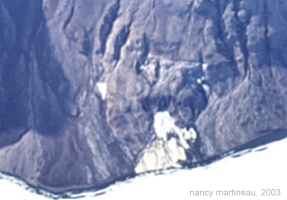|
Top: Colour Peak gullies, Axel Heiberg. Middle: Gypsum Hill cold springs, Axel Heiberg. Bottom: Eureka retrogressive thaw slumps, Ellesmere Island. |
An
Investigation of Martian and Arctic Gullies: The Role of Ground Ice and Salt-Saturated Ground Water in
the Development of Terrestrial Analogues
Ph.D. Thesis Summary Supervisor: Prof. Wayne H. Pollard (pollard@felix.geog.mcgill.ca) The
process of thermoerosion, combined with the distinct mechanics behavior of
frozen soils, is known to alter the formation of gully weathering; yet only
sparse and fragmented information is available on the subject. Gullies
are small, steep-sided channel, often with an alcove head scarp and a debris
apron, caused by erosion due to the intermittent flow of water. Although
investigations have been limited thus far to temperate regions, gullying is
also widespread under sub-freezing polar desert conditions. Indeed, evidence
suggests that almost any concentrated flow may there give rise to a classic
type of slope gully morphology. Moreover, the minute amounts of water
required to create such distinctive landforms may only involve very local
melting of near-surface ground ice or more intriguingly perhaps, mineralized
groundwater flow through unusual piping systems. In all cases, as
observed in the Canadian High Arctic, the resulting landforms make for unique
and stunning sceneries. The goal of the proposed research is to develop
a better understanding of the on-slope processes that contribute, in cold
environments, to gully development and deposition within the debris aprons, as
well as the variations in their interactions. This field-based study,
supported by laboratory analysis and modelling, will examine various gully
scale channels throughout Ellesmere and Axel Heiberg Islands that are directly
related to some combination of perennial spring occurrences and episodic
buried flows or seasonal runoff from melting snowpack and the degradation of
ground ice. This study also intends to contribute valuable information
concerning hydrological systems operating in the presence of permafrost and to
assess the applicability of terrestrial gullies in the Arctic to reconstruct
the geologic history of the relatively young and morphologically similar
features recently reported on Mars at mid-to-high latitudes.
|
|
|



